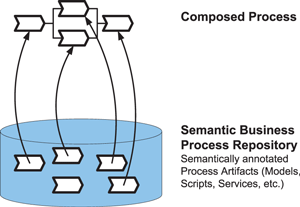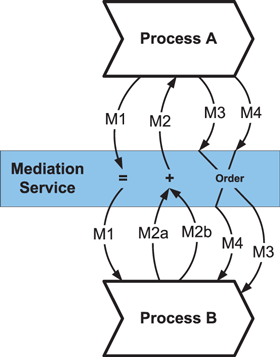by Matthias Born, Christian Drumm, Ivan Markovic and Ingo Weber
The SUPER project (Semantics Utilized for Process Management within and between Enterprises) is working on improving the modelling and management of business processes. This will be achieved by integrating semantic technology with business process management (BPM), and would provide answers to two of the most prominent issues emerging in this area: shifting control of processes from IT professionals to business experts, and scaling up BPM to support processes of higher complexity.
SUPER is an EU-funded Integrated Project that has a duration of three years and is under the coordination of SAP. It started in April 2006 and unites nineteen partners and approximately sixty researchers. The project consortium is a balanced blend of industrial partners, use case partners and academic research teams from all over Europe.
The motivation behind SUPER arises from the challenges of the increased frequency with which business models and the contexts of enterprises change in todays world. This rate of change is generally caused by new internal or external business requirements (eg closer integration with suppliers and customers, implementation of new industry-specific standards or deployment of new application components), which may originate from emerging business opportunities or new regulations from legal bodies. In this environment, two requirements are paramount: to provide fast and easy access to the process space of an organization and to enable swift adaptation of operational business processes.
The major objective of SUPER is to raise business process management from the IT level to the business level. This objective requires that BPM be accessible to business experts and business analysts without requiring detailed technical expertise. Semantic Web and particularly Semantic Web services promise to enable users to perform complex tasks without requiring an understanding of the underlying technology. Therefore, this project aims at providing a framework that is context-aware and based on Semantic Web Service technology, and which acquires, organizes, shares and uses the knowledge embedded in business processes and IT systems. This knowledge is presented to business experts and analysts in an understandable format through a novel process-modelling tool. Using this tool the framework enables them to easily analyse, change and create business processes, leading to a higher degree of agility in companies.
SUPER achieves this objective by adding semantic annotations to BPM artefacts (like process activities, services and execution artefacts), thereby making these artefacts accessible for advanced querying and reasoning. Using these querying and reasoning approaches, the tools developed in SUPER support users during business process modelling through techniques such as Semantic Business Process Discovery, Semantic Business Process Composition and Semantic Business Process Mediation.

Business Process Discovery provides support to the business expert during the modelling phase by simplifying the reuse of existing artefacts. For this task we provide a rich formal framework for the description of business process models, covering all workflow perspectives (data, control, resource). This enables the business expert to pose expressive queries to the business process repository in the search for existing process components. Semantic Business Process Composition aims at enabling business experts to operationalize their business processes directly, by automatically deriving an executable process from a conceptual business process model (see Figure 1). Semantic Business Process Mediation facilitates Semantic Business Process Composition by enabling the seamless integration of processes originating from various stakeholders in a collaborative business process (see Figure 2). The use of such technology facilitates the task of modelling business processes in two ways: first, it improves the quality of the models through the reuse of established and optimized process components; and second, it reduces the process modelling time by avoiding reinventing the wheel.

The chosen testbed for the achievements of the project is the telecommunication sector, where the limitations of traditional BPM approaches like cost and delay of process set-up are clearly visible, and currently limit the development of advanced, more agile business models.
Link:
http://ip-super.org/
Please contact:
Matthias Born, Christian Drumm, Ivan Markovic and Ingo Weber
SAP Research, CEC Karlsruhe, Germany
E-mail: {Mat.Born, Christian.Drumm, Ivan.Markovic, Ingo.Weber}![]() sap.com
sap.com









